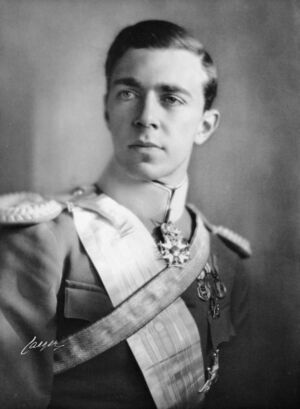Gustaf Adolf
( royalty, deep state operative?) | |
|---|---|
 | |
| Born | Gustaf Adolf Oscar Fredrik Arthur Edmund 22 April 1906 |
| Died | 26 January 1947 (Age 40) |
Cause of death | |
| Nationality | Swedish |
| Alma mater | • Lundsbergs boarding school • Military Academy Karlberg • Royal Swedish Army Staff College • Stockholm School of Economics • Uppsala University |
| Parents | • Gustaf VI Adolf • Princess Margaret of Connaught |
| Children | |
| Victim of | |
Swedish royal who probably could have played an important role in post war Europe had he not died in 1947 air crash. | |
Prince Gustaf Adolf Oscar Fredrik Arthur Edmund, Duke of Västerbotten was a Swedish prince, who for most of his life was second in the line of succession to the Swedish throne. He was killed on 26 January 1947 in an airplane crash on the way home from a meeting with Princess Juliana and Prince Bernhard of the Netherlands. While the crash most likely was an accident,[citation needed] the meeting indicates that he was active in the planning of the post-war order of Europe.
Contents
Background
Gustaf Adolf was the eldest son of Gustaf VI Adolf, who was crown prince for most of his son's life and ascended the Swedish throne three years after his son's death. The younger Gustaf Adolf was succeeded as second in line by his only son, at the time only 9 months old, who would later succeed his grandfather in 1973 as King Carl XVI Gustaf.
Politics
Gustaf Adolf was not unsympathetic towards the Nazi movement in Germany in the 1930s. As an official representative of Sweden, Gustaf Adolf met with many Nazi leaders, including Adolf Hitler and Hermann Göring (the latter had lived in Sweden and had many friends among the Swedish upper class).
His grandfather, King Gustav V was strongly pro-German and anti-Communist his whole life, and his father-in-law, Charles Edward, the deposed Duke of Saxe-Coburg and Gotha, was one of the few members of any of the former German princely houses who was a Nazi supporter,[1] but this does not mean Gustaf Adolf was.
As the prince very rarely spoke of political matters and left no known written evidence of any political sympathies of any kind, the subject remains very much a matter of speculation. The point is somewhat moot, as the German government was seen as a fully mainstream option in the Western ruling classes.
World War II
During the World War 2 and Swedish neutrality, he was at the Defense Staff and commander of XIII. cavalry battalion 1941–42. He participated in the preparation of the order on "resistance in all situations" in 1942, and wrote the draft of "If the war comes" in 1943 which was sent out to Swedish households.
In 1944, he was head of the staff's army department, which was characterized by intensive work to support voluntary Norwegian and Danish military units that existed in Sweden, the so-called police troops, a work he put his soul into. This work would also have put him in contact with British and American services.
His task as Crown Prince was, however, to follow the policy of neutrality issued by Prime Minister Per Albin Hansson during the first days of World War II.
Gustaf Adolf expressed his support for Finland during the Continuation War of 1941–1944, and would even have liked to participate as a voluntary soldier in the Winter War of 1939–1940, but the King's disapproval prevented this from happening.
Some leading Swedish politicians were adverse to the possibility of seeing Gustaf Adolf inherit the throne, and one prominent Social Democrat publicly uttered that the prince was "a person who must never be King".[2]
References
- ↑ Die Zeit, 2001
- ↑ Per Svensson in Han som aldrig fick bli kung ISBN 91-1-301498-6 Norstedts 2006 p. 281
Wikipedia is not affiliated with Wikispooks. Original page source here